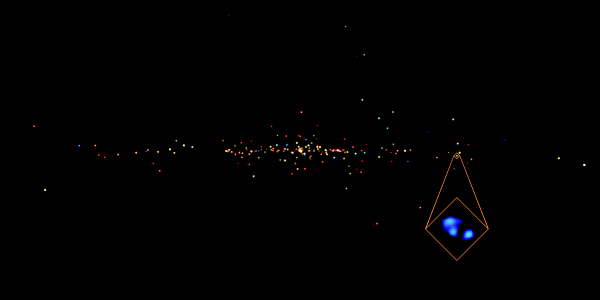Athena builds on the legacy of ESA's high-energy space observatories
Our knowledge of these energetic objects relies upon observations made by instruments in space, since Earth's atmosphere blocks out all high-energy photons (X-rays and gamma rays) coming from deep space.
The first breakthrough came in 1946, when X-rays from the Sun were detected for the first time, though the first source of X-rays originating beyond the Solar System was not found until June 1962. These early detections were made by suborbital sounding rockets, but it was clear that satellites could provide much more prolonged and detailed information about the high-energy Universe.
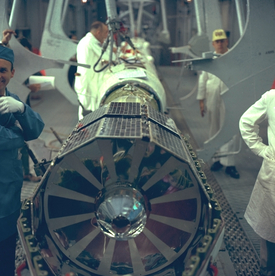 |
| ESRO-2B launch preparations. Credit: ESA |
Even before ESA was created, its predecessor, known as the European Space Research Organisation (ESRO), was at the forefront of this new field of study.
One of ESRO's first satellites, ESRO-2B, successfully observed solar X-rays and cosmic radiation between 1968 and 1971, but the Organisation's first true astronomy satellite was TD-1, which was launched in March 1972. Although it was primarily designed to study ultraviolet sources, it was also able to scan the entire sky for objects that emitted X-rays and even more energetic gamma rays.
The first complete Galactic survey in gamma rays was undertaken by COS-B, which was launched in August 1975, soon after the formation of ESA. Although COS-B's gamma-ray detector was not able to map the sky in great detail, with an angular resolution of about two degrees, it identified a broad band of gamma ray emission from the galactic centre, as well as 25 point sources.
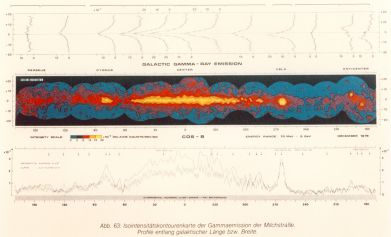 |
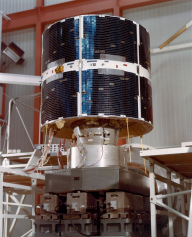 |
| COS-B: Milky Way in gamma rays | COS-B. Credit: ESA |
A major advance came with the launch of ESA's first X-ray Observatory Satellite (EXOSAT) on 26 May 1983. Its highly eccentric orbit made it possible for the first time to make uninterrupted observations of the time variability of X-ray sources for up to several days at a time.
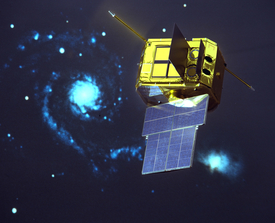 |
| EXOSAT. Credit: ESA |
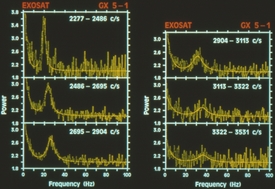 |
| X-ray spectra from GX 5-1. Credit: ESA |
The EXOSAT payload included X-ray imaging telescopes and two non-imaging X-ray instruments which provided spectra and light curves that provided insights into the nature of X-ray sources such as black holes or neutron stars.
During its three-year life, EXOSAT made nearly 1800 observations of the X-ray emission from many classes of astronomical objects, including active galactic nuclei, white dwarfs, supernova remnants, galaxy clusters and X-ray binaries.
EXOSAT discovered an entirely new phenomenon - quasi-periodic oscillations in the radiation from a bright binary system consisting of a neutron star accreting material from a nearby binary companion. This discovery allowed the properties of the material flowing around a neutron star to be studied in detail for the first time.
Another discovery was a binary system with two stars orbiting each other every 11 minutes and another binary in which a massive star was feeding a nearby black hole. EXOSAT also surveyed 48 Active Galactic Nuclei (AGN), providing key evidence that their enormous high energy photon output originates from small regions close to the supermassive black holes at their centres.
Scientist's from ESA's Science Directorate also played a role in Italy's BeppoSAX mission, which operated 1996-2002. Among its achievements was the first detection of an X-ray afterglow from a transient gamma-ray burst.
Current observatories
Meanwhile, in 1982, even before the launch of EXOSAT, scientists began to propose the development of a multi-mirror telescope with a much larger X-ray collecting area than any previous observatory. By enabling lengthy observations of X-ray sources with unprecedented sensitivity, this new observatory would ensure that Europe remained at the forefront of studies of the high energy Universe.
In June 1988, ESA selected the X-ray Multi-Mirror observatory (later renamed XMM-Newton) as one of the cornerstones of its Horizons 2000 long-term space plan. By far the largest and most advanced space observatory ever developed in Europe, XMM-Newton was launched on 10 December 1999. It is still operational today.
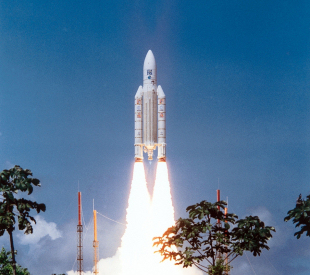 |
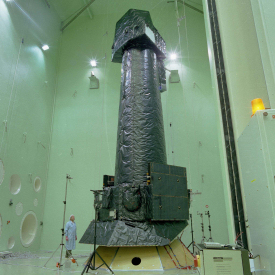 |
| Launch of XMM-Newton. Credit: ESA-CNES-Arianespace / Photo Service Optique CSG | XMM-Newton flight model. Credit: ESA |
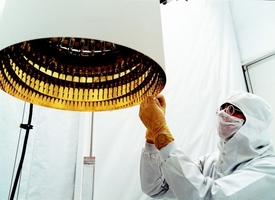 |
| A single curved XMM-Newton mirror. Credit: ESA. |
XMM-Newton's instruments are designed to focus X-ray photons in an energy range from 200 eV to 12 keV. At the heart of the tube-shaped observatory is an X-ray telescope, which has three mirror modules at one end and a suite of six instruments at the other end. Each telescope contains 58 gold-coated, curved mirrors in a nested configuration. These focus incoming X-rays onto three CCD imaging cameras, together with two reflection grating spectrometers that provide a more detailed analysis of each source's X-ray spectrum.
During 17 years of operation, XMM-Newton has observed more X-ray sources than any previous mission. The latest version of its source catalogue includes almost half a million unique sources, the overwhelming majority of which were previously unknown. More than 5000 scientific papers have been published, using XMM-Newton data so far. This number has been steadily increasing at a rate of over 300 hundred per year.
The observatory has revolutionised our scientific understanding of the energetic Universe, including supermassive black holes at the heart of galaxies, the formation and evolution of stellar black holes created by massive, exploding stars, and the conditions in remote quasars and active galaxies.
ESA also operates the INTEGRAL gamma-ray observatory, which complements XMM-Newton's studies by observing the most energetic objects in the Universe. Selected by ESA in 1993 and launched on 17 October 2002, INTEGRAL is also still operational.
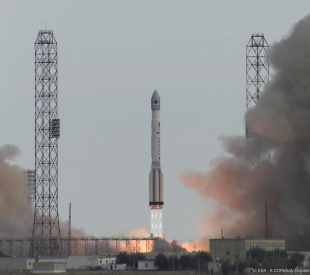 |
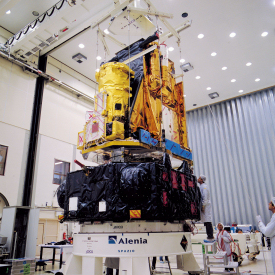 |
| INTEGRAL launch. Credit: ESA-S. Corvaja | INTEGRAL. Credit: ESA-A. Van Der Geest |
The most sensitive gamma-ray observatory ever launched, it provides images and spectra over a wide range of X-ray and gamma ray wavelengths. Its multi-layer detector can observe discrete gamma ray sources over the energy range 15 keV to 10 MeV, whilst its spectrometer can analyse sources with unprecedented energy resolution.
INTEGRAL has so far discovered more than 600 gamma ray sources, resulting in over 1000 scientific papers. Many of these sources have been the subject of follow-up investigations by XMM-Newton.
Advancing knowledge
In the early days of high-energy astronomy, very few objects were known. Foremost among the early discoveries were the Crab and Vela pulsars – the first pulsating X-ray sources to be detected within the remnants of supernova explosions.
As time has gone by, ESA's observatories have enabled the inner secrets of these objects to be revealed. INTEGRAL, for example, has been able to locate the source of energetic particles in the Crab Nebula. It has also made the first hard X-ray observations of the steady wind of highly energetic electrons and positrons that is emitted by the Vela pulsar.
Meanwhile, objects much further from home can now be studied. One highlight from the XMM-Newton mission has been the discovery of a pulsar that is 1000 times brighter than previously thought possible.
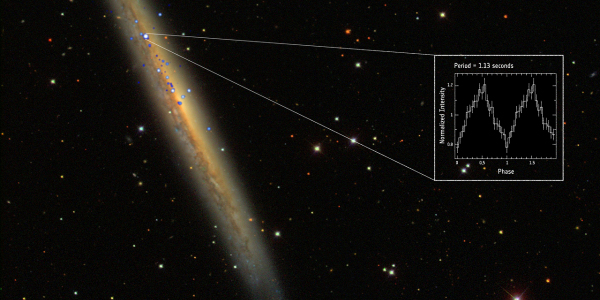 |
| NGC 5907 X-1: record-breaking pulsar. Credit: ESA/XMM-Newton; NASA/Chandra and SDSS |
Observations from both XMM-Newton and INTEGRAL are often coordinated in order to widen the window of observation. One example is a pulsar which was found to be bright in X-rays for several weeks, before emitting in radio waves as its X-ray emission started to decline.
Another class of object that has been extensively surveyed by ESA's high-energy observatories is supermassive black holes at the heart of galaxies. One of these monsters lurks at the heart of our Galaxy. XMM-Newton and INTEGRAL have enabled astronomers to study how and when this now quiescent object was once much more active.
ESA's space observatories have also revealed the highly dynamical phenomena associated with supermassive black holes surrounded by accretion disks of hot, infalling material, by in-depth studies of AGN in the local Universe, such as NGC4151. These observations have a potential impact on our understanding of fundamental physical processes, because they represent one of the very few ways to probe how matter behaves in a Strong Gravity regime.
Following the 2015 discovery of gravitational waves by ground-based detectors, XMM-Newton and INTEGRAL have now been given a new task - to identify the high-energy sources of these elusive waves. On 17 August 2017, INTEGRAL detected a burst of gamma rays linked to the gravitational waves released by the collision of two neutron stars.
Into the future
If all goes according to plan, XMM-Newton and INTEGRAL will continue to operate for many years to come. However, the next generation of observatories is already being planned.
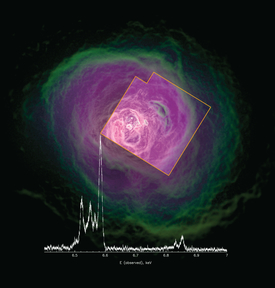 |
| X-ray view of the Perseus cluster. Credit: Background: NASA/CXO; Spectrum: Hitomi Collaboration/JAXA, NASA, ESA, SRON, CSA |
ESA has recently decided to participate in Japan's X-ray Astronomy Recovery Mission (XARM), which will replace the Hitomi satellite, which failed before beginning routine operations in March 2016. Hitomi was an important link with the ESA's future programme since it carried an X-ray Calorimeter Spectrometer, a smaller version of one of the instruments proposed for Athena.
Before its demise, Hitomi mapped, for the first time, the motion of gas across a large part of the Perseus cluster of galaxies. Such high-quality, hard X-ray spectra are also crucial for determining the total mass of clusters - the largest gravitationally bound structures in the Universe - and the physical processes taking place within them. The distribution of galaxy cluster mass in the Universe is important because it constrains cosmological models.
Revealing how galaxy clusters form and evolve will be one of the primary tasks of the next-generation Athena observatory, together with studies of accreting black hole physics and evolution.
Building upon the successes of past and present missions, the future of high-energy astronomy in Europe is looking bright.

